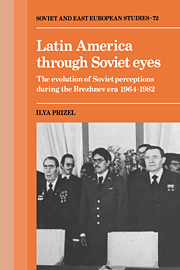 Latin America through Soviet Eyes
Latin America through Soviet Eyes Book contents
- Frontmatter
- Contents
- Preface
- Acknowledgments
- Introduction
- Part I Soviet perceptions of Latin America's global role
- Part II Soviet perceptions of Latin American social structures
- Part III Soviet–Latin American relations during the Brezhnev era
- Introduction
- 11 Case study: Mexico
- 12 Case study: Chile
- 13 Case study: Brazil and Argentina
- Part IV Conclusion: the emerging Soviet perception of Latin America and the future of Soviet policy toward the hemisphere
- Conclusions
- Epilogue – Latin America: the Long March
- Notes
- Bibliography
- Index
- Frontmatter
- Contents
- Preface
- Acknowledgments
- Introduction
- Part I Soviet perceptions of Latin America's global role
- Part II Soviet perceptions of Latin American social structures
- Part III Soviet–Latin American relations during the Brezhnev era
- Introduction
- 11 Case study: Mexico
- 12 Case study: Chile
- 13 Case study: Brazil and Argentina
- Part IV Conclusion: the emerging Soviet perception of Latin America and the future of Soviet policy toward the hemisphere
- Conclusions
- Epilogue – Latin America: the Long March
- Notes
- Bibliography
- Index
Summary
Moscow's non-interest in Latin America prior to the Cuban revolution can be attributed to several factors, not the least of which was US influence in the region after World War II. However, it would be simplistic to characterize this influence as the sole basis for Soviet policy, then or later. To begin with, the newly independent states of Asia and Africa in fact monopolized Soviet diplomatic and economic activity in the Third World during the Khrushchev era. Moscow hoped that these new elites, resentful of Western economic and political imperialism, would launch “revolutionary democratic” regimes that would be antibourgeoisie in nature and would practice “positive neutralism” and oppose foreign investment. Latin America's economic dependence on the United States gave rise to no such hopes.
Moreover, the preferred economic models of the USSR and Latin America were incompatible. The Soviet-advocated “import substitution model” – by which Third World nations would develop indigenous industrial capacities so as to substitute locally produced industrial goods for Western imports – had been tried in Latin America in the 1930s and was associated there with inefficiency, technological backwardness, and chronic current account deficits. Only Peronist Argentina, with its antibourgeoisie rhetoric, supported import substitution, signing an isolated bilateral agreement with Moscow in 1952.
The Cuban revolution of 1959 and the reestablishment of diplomatic relations with Brazil in 1961 (which would later deteriorate after the 1964 coup) raised Soviet interest in Latin America but did little to improve Moscow's ties with that continent.
- Type
- Chapter
- Information
- Latin America through Soviet EyesThe Evolution of Soviet Perceptions during the Brezhnev Era 1964–1982, pp. 151 - 154Publisher: Cambridge University PressPrint publication year: 1990
